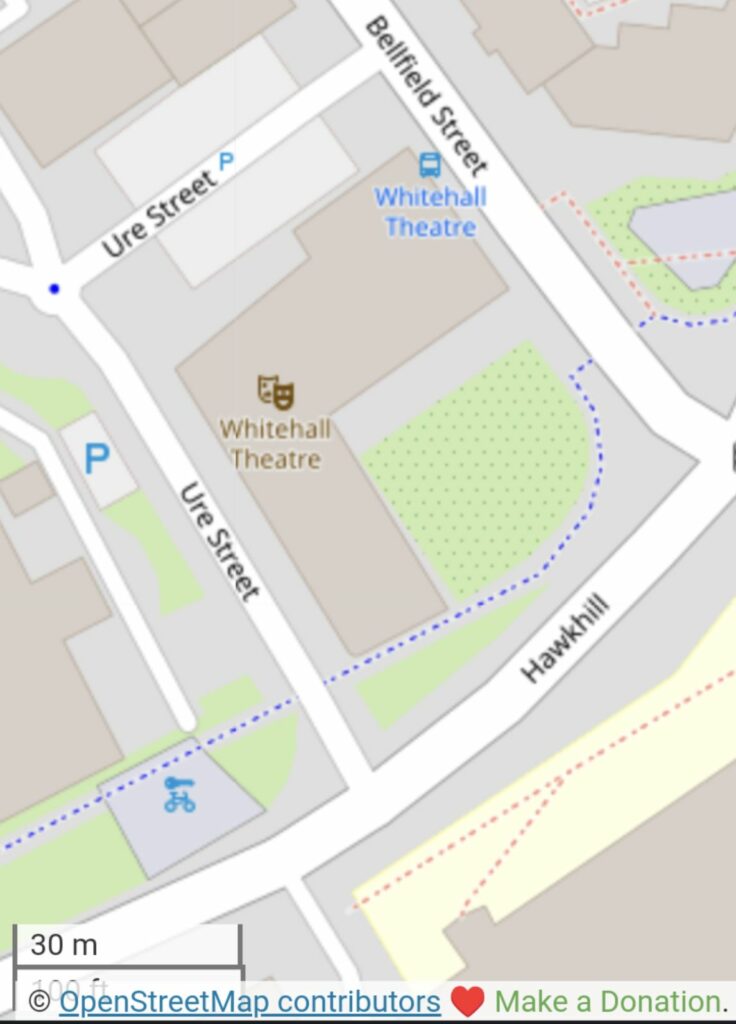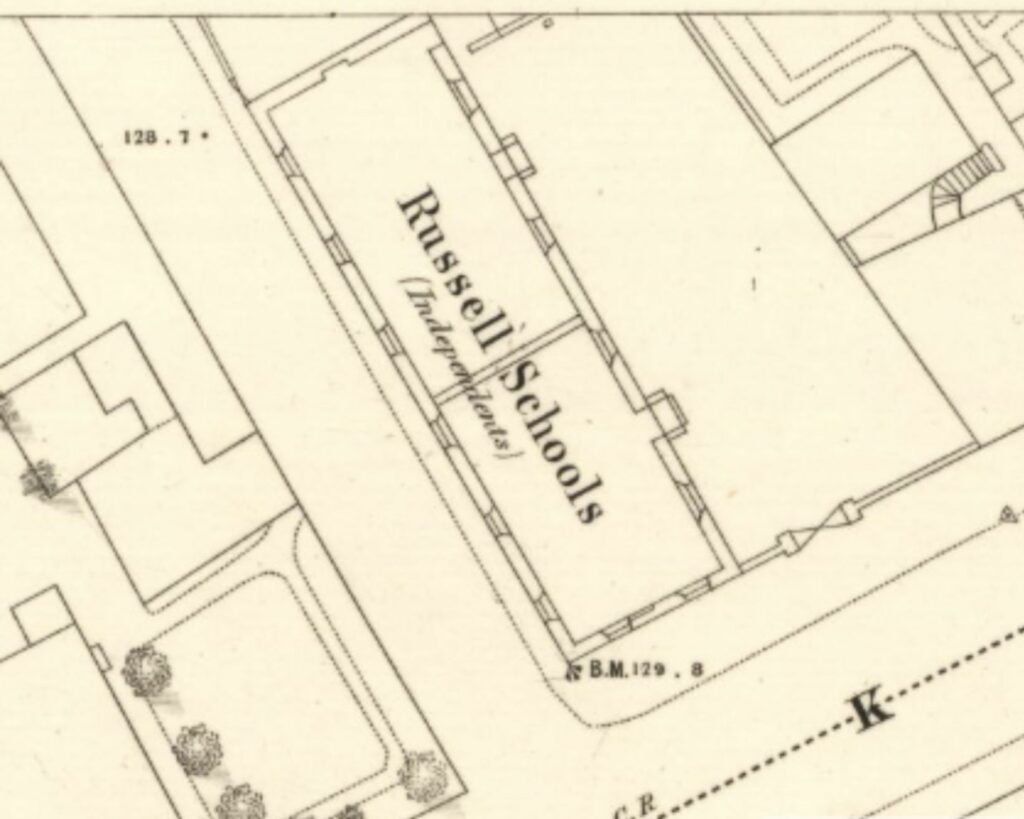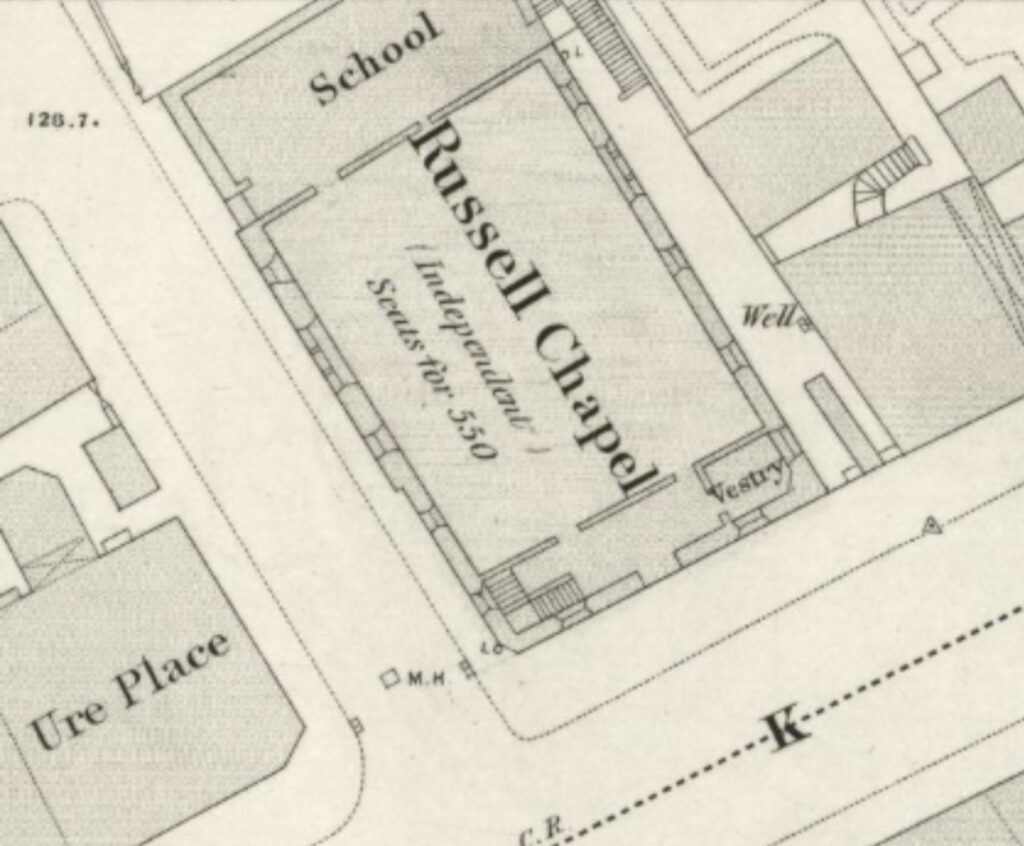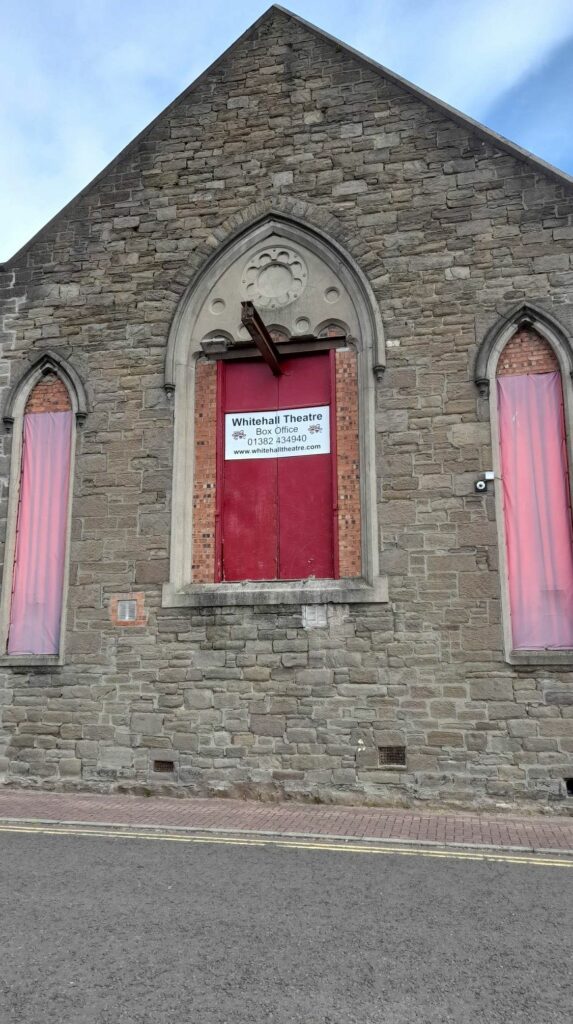Introduction
Not far removed from the University of Dundee Wellcome Trust buildings, standing at the corner of Ure Street and Hawkhill, there is an old church building that is now part of Whitehall Theatre. The building may not seem at all significant at first glance, but it has a rich history that is worth exploring. The building was originally used as a day school and Sabbath school, later became a place of worship for over a century. In the 1960s, the building was purchased by Whitehall Theatre and converted into a theater.

The Russell Schools
1855 – 1868
The Russell Schools as the building would be known was erected in the middle of the 19th century, after the death of Rev. David Russell, minister of Ward Chapel from 1810 to 1848, in whose honour the building was named.
First edition Ordnance Survey maps indicate there was a building of the Russell Schools in Ure Street at least as early as 1857/8.

The building is shown either as “Russell Ch. Indep’t” or “Russell Schools” as seen above. A copy of the Dundee Courier from 7 Nov 1855 states that the buildings in the course of erection were to be denominated “The Russell Schools”.
Scant as the exact details of the initial school building may be, Scotland’s places describes it as “a neat and substantially built school house” with capacity for teaching 90 boys and 50 girls with subjects such as reading, writing, arithmetic, history, book-keeping, knitting, sewing and crochet work all being taught.
The Russell Schools operated both a day school and also a Sunday Sabbath school.
1868
In 1868 a newer church building was erected on the same site. There is some debate over who the architect was but is thought to be David Mackenzie or James Maclaren.

Masters of the school
Of the masters of the school little is known, although it is clear from Isaac Slaters National Directory of Scotland for 1860 Mr William Dempster was master. In later years we learn of the death of John T Coutts master of the Russell Schools in 1869. (note that the 1869 Post Office directory shows the name as John F Coutts, house address at 64 Peddie Street which runs parallel to Ure Street).
Following this period, Mr H.M.Cameron was master of the Russell Schools.
The duties of the master would invariably have touched on things like the overall running of the school, teaching students, maintaining discipline, managing finances, and overseeing the upkeep of the school.
The master was also expected to act as a role model for the students and to provide pastoral care. In addition to these duties, the master may have been responsible for leading worship, administering the sacraments, and providing pastoral care to the students and their families.
I.O.G.T
The Independent Order of Good Templars (I.O.G.T.) was a temperance organisation that was founded in 1851. It was one of the most successful temperance organisations in the world, and it had a strong presence in Dundee in the 19th century with the first lodge opening in 1853.
By the end of the 19th century there were over 100 lodges in Dundee. Abstinence from alcohol was a driving factor thought to help reduce poverty, crime and disease. Through organising of social events, educational meetings, free library and soup kitchen the IOGT became popular and a powerful force of social reform among the working classes.
Throughout the 19th century we learn of different IOGT meetings held in Russell Schools : Belmont, Russell, Day Star, Pleasant Home just a few of the names of different good templar lodges that used the buildings.
Changing Times
The growing conflict over views on education became increasingly evident during the 19th century:
- The Church of Scotland was the established church in Scotland at the time, and it had a monopoly on religious education in public schools.
- The state, however, was increasingly interested in taking a more active role in education, and it began to introduce legislation that would give it more control over the curriculum.
- This led to a conflict between the church and the state, as the church was reluctant to give up its control over religious education.
- In the end, the state was able to assert its authority, and religious education in public schools became more secularised.
- The church argued that religious education was essential for the moral and spiritual development of children, while the state argued that it was important for children to be educated about different religions and cultures.
- The conflict between the church and the state came to a head in the 1870s, when the state passed the Education Act of 1872. This act gave the state control over the curriculum of public schools, including religious education.
- The church responded by setting up its own system of denominational schools, which were funded by the state but were not subject to state control.
- The system of denominational schools continued until the 1918 Education Act, which brought all schools under the control of the state.
Architecture
The architectural features of the Russell Schools building are quite unique. Whilst the building is made of sandstone and has a Gothic Revival style. The façade features a large arched window. Perhaps the most unusual feature (not part of the original design) is an iron girder extruding from the west of the old church building, used with a hoist to this day to load heavy stage scenery etc in and out the building.
The windows have been bricked up with red-brickwork not unlike the brickwork on the property immediately to the north and adjacent to this building. Although not certain it may be that the red-brickwork visible to the north formed part of an old School on these premises before the building work of 1868/9, but this is only speculation.
The earlier Ordnance Survey maps show a much more rectangular building divided in two, north and south, with six windows on the west (three in each “half” of the building) and four windows on the east of the building (two per each “half). The original school building appears to have been very much symmetrical in nature, possibly with a “playground” of sorts to the east, although the function of the ground uncertain, all that is evident from the early map appears to be a “gate”(?) on the Hawkhill to the immediate east of the original building.

Photograph by Robert Duncan
Congregational roots
The roots of Russell Schools can be traced back to the late 1700s when the first Congregational church in Dundee was formed. Congregationalism is a form of Christianity that emphasises the independence of local churches, not conforming to the established Church of Scotland.
In 1793, a second Congregational church was established in Dundee at the West Port as an Independent chapel. Its first minister was Neil Douglas, who had previously been a Secession minister and labelled by some as “wavering nonconformist”. The church was known by the name West Port chapel. It’s location immediately to the south of the old Tay Mills on West Marketgait near the location of the Grovesnor Casino in more recent times.
Robert Haldane
A nephew of Admiral Adam Duncan, 1st viscount of Camperdown, Robert Haldane was instrumental in the establishment of places of education for young Christian men and established teaching seminaries and tabernacles for them to preach in. During the latter part of the 18th century Robert had become friends with Rev William Innes of Stirling who had in mind to come to Dundee to teach in one of the academies that Haldane had set up.
Tabernacle / Temple
Dundee’s Tabernacle opened in North Tay Street on October 19, 1800. The building also known as “The Temple”, and later still became St David’s Free church, stood at the corner of West Marketgait. Around the same time Dundee’s “first Academy” was setup after an false start. The first rector of Dundee Academy thereafter was Andrew Duncan, a student who had studied mathematics and graduated in 1796, after Andrew resigned from his post some 20 years after he would take up a post as Professor of Mathematics at St Andrews university.
You may wish to view a more recent view of the location of the old Tabernacle since demolished note the characteristics oval shapes in the old Tay mills building standing adjacent to the north. Visible then as today.
Troubled times
Education was not the only thing in turmoil, the church was certainly no stranger to this and some of the early Congregationalists formed a breakaway group that met initially in Burial Wynd (now Barrack Street adjacent to Dundee’s Howff) before relocating to Sailors’ hall in Yeoman shore. It was at this time Dr David Russell would be ordained. The congregations at Sailors’ hall and West Port chapel would then amalgamate and witness the building of Ward Chapel in 1833.
Circle of Life
The Russell Schools building was used initially as a day school, and Sabbath school, labelled an early “preaching station” or “mission church”, ultimately a place of worship for the best part of a century until the 1960s. It was then purchased by Whitehall Theatre and converted into a theatre.
The Russell Schools building, sadly all but nearly forgotten these days, is a significant landmark in Dundee’s history. A reminder of the rich history of Congregationalism in Dundee and like the statue of his uncle in the city centre, a testament to the vision of Robert Haldane, who helped to establish places of both education and also worship for young Christian men and women.
Living in a completely different period of time, so far removed from modern society; times when an altogether different form of discipline was exercised. The building has served as a place of education, worship, social reform and entertainment
During these “changing years” I can’t help but wonder if the Haldane brothers perhaps learned a thing or two of the old Duncan motto “Disce Pati” (learn to suffer or discover patience) – a calling for endurance and resilience in the face of adversity.
Credits
- Dundee City Archives
- Dundee Congregational Church
- Historic Environment Scotland
- National Library of Scotland
- University of Dundee
- Whitehall Theatre
